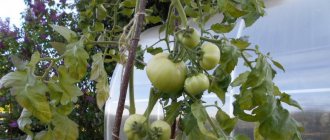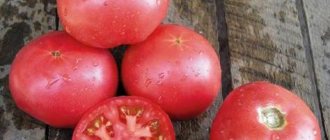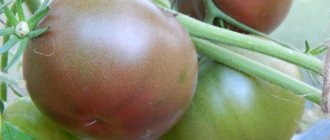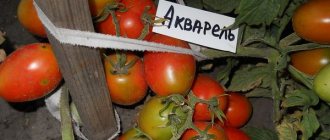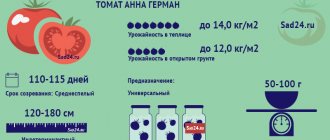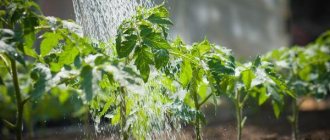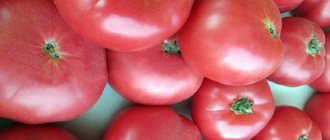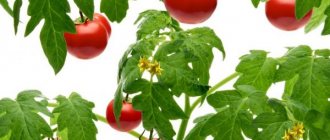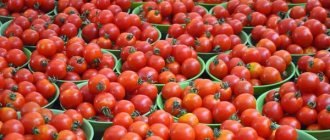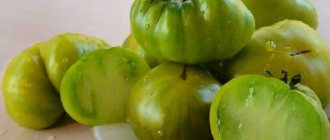Mistakes when growing hybrids
When buying seeds, they look at a beautiful photo, but don’t read the description.
Tomatoes intended for the greenhouse are planted in open ground and vice versa. Many people do not use the greenhouse space productively and plant determinate, low-growing tomatoes in it. It is more correct to grow vigorous hybrids (indeterminate) in protected soil; they grow to the top of the greenhouse and produce more fruit per unit area. Many people do not follow the recommended planting pattern and plant too often. There are established landing rules.
| Bush type | Scheme |
45*60 cm
Other growing mistakes:
- improper formation of the bush;
- excessive application of fertilizers;
- poorly organized watering.
Tomato hybrids are worth growing. New products are pleasing not only with their resistance to diseases and high yields, but their fruits are distinguished by good taste and marketable appearance.
Advantages and disadvantages of a hybrid
The main advantages of the variety include:
- precocity;
- high productivity;
- high nutritional value of ripe fruits.
There are few disadvantages to these tomatoes;
- fruits do not tolerate transportation well;
- the crop can be stored after harvesting for no more than 7 days;
- the need for gartering and bush formation.
Reviews from those who planted the Lily Marlene tomato say that the fruits of the variety are unusually tasty, ripen well, and caring for the planted hybrid does not require much effort.
Nuances for open ground and greenhouses
The height of greenhouse bushes reaches 2 meters. This type of growth requires a lot of nutrients. To direct nutrition to the developing ovaries, the tops of plants are pinched, artificially limiting the height.
When forming a bush with 2 stems, the greatest return is observed both in open ground and in greenhouse conditions. But in a greenhouse, the yield is usually 2-3 kg higher.
To maintain humidity and temperature within normal limits, the greenhouse is ventilated every day without creating drafts. At elevated temperatures and humidity, bacterial spores and many pests multiply quickly.
According to the rules of crop rotation, tomatoes are planted in the same bed where cabbage, carrots, herbs and legumes were previously located. After these plants, the soil is not depleted and is quite suitable for the full development of tomato. It is not recommended to plant Lily Marlene in those beds where potatoes, peppers and eggplants previously grew.
The top layer of soil in a greenhouse must be replaced every year. If this is not possible, the soil is dug up with the addition of a full range of minerals. Then pour in a hot solution of potassium permanganate and copper sulfate.
Description of the hybrid tomato Lily Marlene and breeding of the variety
The unusual name of the Lily Marlene tomato refers to an old forgotten song that was popular during the Second World War. It sang about two different girls with the names Lily and Marlene, whom a young soldier met. Those who have heard this simple song probably remember the inexplicable admiration from the heartfelt words.
Of course, gastronomic preferences are not comparable to emotional experiences. But for real gourmets, the taste of ripe tomatoes called Lily Marlene can evoke no less strong admiration. Rich in vitamins, with a deep pink hue that shimmers in the sun, these vegetables will decorate any summer salad or side dish. They are valued for their high nutritional qualities and are in great demand in markets.
Hybrid Lily Marlene f1 belongs according to the classification to beef tomatoes. These are large-fruited tomatoes weighing more than 150 g, with fleshy pulp.
Beef tomatoes are less susceptible to fungal and viral diseases, and the taste of the fruit is always at a high level.
Distinctive features
Indeterminate type, bush height – 1.8–2 m. Medium foliage, emerald-colored leaves. The first inflorescence is formed above the 6-7th leaf. The ovaries are collected in racemose inflorescences, each of which forms 4-5 fruits.
High growth requires mandatory staking of plants. To avoid dense plantings, the crop is regularly planted.
The species is early ripening, 90–105 days pass from the moment of sowing to full ripening. The hybrid is recommended for cultivation in open ground and greenhouse conditions.
Productivity is high, from 1 sq. m, up to 16 kg of fruits are collected, placing no more than 4 seedlings per 1 sq. m.
The hybrid genes contain good resistance to the main diseases of the nightshade family.
The average weight of the fruit is 220–330 g, the shape is round, the color is rich pink with a reddish tint. The taste is excellent, sweet, with a barely noticeable sourness characteristic of tomatoes. The pulp is fleshy, dense, there are 5-6 seed chambers. The peel is thin, so tomatoes cannot retain their presentation for a long time. They cannot be transported and can be stored in the refrigerator for no more than a week.
READ MORE: Tomato Vostok f1 description and characteristics of the variety, yield with photos
From the reviews of those who planted it, it follows that the best option for consuming ripe vegetables is preparing various dishes fresh. These tomatoes are not suitable for canning and pickling, but they are processed into juices, ketchups and sauces.
The photo shows Lily Marlene's tomatoes.
Sowing work begins 2 months before planting in the ground. Before sowing, prepare the seed material, container and soil.
Purchased seeds are soaked in a pink potassium permanganate solution for 20 minutes, then washed with running water. It is not possible to collect seed material of hybrid crops on your own; they are bought every time. The manufacturer takes care of the quality of the seeds by carrying out all the necessary treatments.
To increase germination, soak in a growth stimulator for 10-11 hours. Stimulants used include Kornevin or Zircon.
Any container will do - a common wooden box, separate plastic or peat containers. Before sowing, they are treated with a strong solution of manganese and drainage holes are made at the bottom. If this is not done, moisture will accumulate, which can lead to the development of fungal diseases.
The soil is prepared from garden soil mixed with peat and humus in equal quantities. River sand is added as a leavening agent. The finished mixture is poured with a hot solution of manganese or steamed in the oven at a temperature of 60 degrees for 10 minutes. The disinfected soil is laid out in planting containers, filling them two-thirds.
The seeds are sown to a depth of 1.5 cm, sprinkled with soil on top, lightly compacted and watered with warm, settled water from a spray bottle. The containers are covered with film and left indoors at a temperature of at least 24 degrees. Periodically, the film is removed to ventilate and moisten the soil. The covering material creates greenhouse conditions, and the seeds germinate faster.
Seedling care
As soon as the seeds germinate, the containers are placed on the windowsill to provide the right amount of light. Daylight hours should be at least 13 hours. If there is insufficient light, install lamps.
Water the seedlings with warm, settled water as the top layer of soil dries out. Watering is carried out from a shallow watering can, without flooding the sprouts. After watering, the soil is loosened superficially, ensuring breathability.
When two true leaves are formed, the seedlings are picked and placed in separate containers. Picking is necessary for more intensive development of seedlings. If the seeds are sown in peat containers, picking the seedlings is not required. 2 weeks after picking, if growth is poor, the seedlings are fed with liquid fertilizer for tomatoes.
10 days before planting in the ground, seedlings are hardened outdoors at a temperature of 16 degrees. First, the containers are taken out into the open air and left for 1 hour. Gradually the time is increased to 10 hours. With sufficient hardening, the leaves acquire an emerald hue.
Before planting, superphosphate is added to the soil to improve fertility. The holes are made no deeper than 20 cm, a little wood ash is placed at the bottom of each and filled with warm water.
Landing
For 1 sq. m place 3-4 seedlings in a checkerboard pattern. When planted in this way, plants do not suffer from lack of light and are freely ventilated. This is necessary to prevent the development of fungal infections.
After the hole is compacted, watered with warm, settled water and the tomatoes are left to get used to the new place for 8-9 days.
Further care
Water the seedlings after sunset or early in the morning when the sun is not at full strength. For irrigation use only warm water. You can heat it in a barrel exposed to the sun.
After watering, the soil is loosened. Removing weeds is essential for healthy plant growth. Pests and disease-causing spores often breed in weeds. To help the beds retain moisture longer, they are mulched. Mulch also serves as a preventive measure in pest control.
The crop is fed three times throughout the entire season: during the flowering period, during the formation of fruits and at the time of fruiting. The tomato responds well to mullein infused with water and bird droppings. The ratio of organic matter to water is at least 1:15, otherwise root burns are possible. Superphosphate or a full complex of minerals are also used as fertilizers.
The bush is formed into two stems, removing all other stepsons. With this technique, you get the maximum return. Also regularly remove the lower leaves up to the first cluster so that they do not come into contact with wet beds.
READ MORE: Tomatoes de Barao characteristics and description of the variety, cultivation features
To garter plants, a wooden or metal support is installed next to each bush, to which the stem and fruitful branches are fixed as they develop. A trellis is also used for fixation. Supports are installed on different sides of the beds and a wire is stretched horizontally, to which the seedlings are tied with soft fabric ribbons.
Diseases and pests
The hybrid resists fungal and viral infections well, however, as a preventive measure, plants are sprayed with fungicidal agents or a weak solution of manganese. Potassium permanganate is treated immediately after transplantation. Also, before transplanting, for preventive purposes, tomato beds are spilled with copper sulfate.
In case of fungal infection, the drugs “Fitosporin” or “HOM” are used for treatment. Seedlings can get sick if crops from the nightshade family are planted in the neighborhood. In this case, all plants are treated at once.
If aphids, slugs and Colorado potato beetles are found on the site, the stems of the bushes are sprayed with a soap solution and each seedling is carefully inspected, preventing the pests from spreading. The Colorado potato beetle and its larvae are collected by hand. If there is a lot of pests, use insecticides “Prestige” or “Confidor”.
The height of greenhouse bushes reaches 2 meters. This type of growth requires a lot of nutrients. To direct nutrition to the developing ovaries, the tops of plants are pinched, artificially limiting the height.
When forming a bush with 2 stems, the greatest return is observed both in open ground and in greenhouse conditions. But in a greenhouse, the yield is usually 2-3 kg higher.
To maintain humidity and temperature within normal limits, the greenhouse is ventilated every day without creating drafts. At elevated temperatures and humidity, bacterial spores and many pests multiply quickly.
According to the rules of crop rotation, tomatoes are planted in the same bed where cabbage, carrots, herbs and legumes were previously located. After these plants, the soil is not depleted and is quite suitable for the full development of tomato. It is not recommended to plant Lily Marlene in those beds where potatoes, peppers and eggplants previously grew.
The top layer of soil in a greenhouse must be replaced every year. If this is not possible, the soil is dug up with the addition of a full range of minerals. Then pour in a hot solution of potassium permanganate and copper sulfate.
The early ripening tomato Lily Marlene allows you to harvest in the first month of summer if the seeds are sown in March. The smooth, rich pink fruits are mainly consumed fresh. In summer salads, you don’t feel their thin, delicate peel at all. But it is precisely because of this that tomatoes do not retain their presentation for more than a week. For the same reason, they cannot withstand transportation.
Ripe vegetables make excellent cocktails, freshly squeezed juices and side dishes. They are processed to produce sauces, adjika, pasta and canned juices. For a more saturated color, pink tomatoes are mixed with red ones.
Ripe tomatoes do not hold their shape after heat treatment, so they are not used for preservation.
- Are common
- Trademark Article No.
- Article 4179303
- PCT Certificate
- Country of origin: Russia
- Composition of Seeds
- Packaging
- 500 pcs in box
- Packaging 10 pcs.
- Individual packaging No packaging
- Package size 15 cm × 8 cm × 0.2 cm
- Dimensions and weight
- Size 8 cm × 0.1 cm × 15 cm
- Gross weight 3 g
How to properly care for tomatoes?
In order for tomatoes to be healthy and grow well, it is necessary to loosen the soil regularly. This should be done once every two weeks; in extreme cases, you can increase the break to 3 weeks, but no more. Twice a season you need to hill up the tomatoes - this is necessary for the formation of new roots. They need to be watered once every 2-3 days, so you should install automatic watering if it is not possible to water them manually. An important element of care is fertilizing with mineral fertilizers, which must be applied once a month. Depending on the characteristics of the soil, the timing of necessary manipulations may vary.
You should also keep an eye on additional shoots - stepchildren. They should be removed in a timely manner, leaving only one stepson closest to the top. This will allow you to get a good harvest of large tomatoes.
Tomatoes can suffer from a number of diseases and pests, so you should carefully monitor their condition, and inspect their stems, leaves, flowers and fruits on every trip to the country in order to detect the disease in time
It is also important to monitor for signs of deficiency of certain substances in the soil and water.
When harvesting tomatoes, it is important to remember that you need to collect not bright orange fruits, but brownish-yellow ones. They are then left to ripen in a warm room.
This measure allows you to avoid spoilage and rotting of freshly picked tomatoes.
How to grow tomatoes
Before planting, superphosphate is added to the soil to improve fertility . The holes are made no deeper than 20 cm, a little wood ash is placed at the bottom of each and filled with warm water.
Landing
For 1 sq. m place 3-4 seedlings in a checkerboard pattern . When planted in this way, plants do not suffer from lack of light and are freely ventilated. This is necessary to prevent the development of fungal infections.
Reference. The day for transplanting into the ground is chosen to be cloudy or planted after sunset.
After the hole is compacted, watered with warm, settled water and the tomatoes are left to get used to the new place for 8-9 days.
Features of reproduction
Lily Marlene is not yet very common in the post-Soviet space. Therefore, asking a neighbor in a summer cottage for a couple of tubers will most likely not work. You should purchase planting material from trusted nurseries or stores, since unscrupulous sellers often sell ordinary ones under the guise of rare varieties of lilies.
Attention!
When purchasing, you need to pay attention to the tubers. The bulb of the Marlene lily is large, about 8-10 cm in diameter, with tightly fitting gray-pink scales
By the way, if they offer you tubers of this variety, showing a photo of multi-flowered lilies of a yellow or white flower, you should refuse. The Marlene variety has exclusively pink petals.
Marlene lilies are most often propagated by children or bulbs. It is not recommended to divide adult bulbs. It is believed that in this way the plant may lose the ability to splice stems, and, accordingly, to multi-flower.
The children are carefully separated from the stem and planted in a separate bed for growing. The chances of getting a multi-flowered lily in this way are only about 50%.
BIF tomatoes - characteristics of the variety
Modern tomatoes can be divided into three main groups:
- Cherry tomatoes. The fruits of this species are small in size, have a good taste, and are used mainly fresh to decorate salads or canapés.
- The following tomatoes are regular (round or oblong). Their weight usually does not exceed 140-160 g. Ripe tomatoes of varieties of this group are universal: they are used fresh and also used for canning.
- And the last group, no less worthy, is beef tomatoes. Ripe tomatoes in this category have a large weight and size (from 160 g to 350-400 g). Another advantage of such tomatoes is their fleshy, juicy pulp with high nutritional value.
When cutting such tomatoes horizontally, you can immediately see the presence of 4-5 segments (instead of a couple in other varieties). Therefore, such tomatoes are easier to cut when preparing salads and other dishes.
The disadvantages of beef tomatoes include the rather delicate skin of the fruit, so they cannot withstand transportation over long distances, and their shelf life at home does not exceed 7 days.
Features of agricultural technology of tomato Leopold F1
It is recommended to grow Leopold tomatoes using seedling technology.
Landing
Since this variety is a hybrid, you cannot prepare its seeds yourself; you will have to purchase them in the store.
In this case, you need to pay attention to the expiration date and name of the manufacturer - only reliable brands can provide high-quality seeds
The group is trusted in the seed market
Unlike many other varieties, Leopold seedlings are planted in the ground at the age of 30–35 days (and not 50–60, as usual). Based on this and taking into account that tomatoes are planted in greenhouses in the middle zone in the second half of April, seeds for seedlings should be sown in early March (remember that the time for full germination to appear can be 4–6 days).
It is recommended to plant tomatoes of this variety in a two-line pattern, maintaining a distance between rows of 50 cm, and between plants in a row - 40 cm. Since tomatoes need garter, when planting you should take care of equipping special supports, which can be trellises, cords , hanging from U-shaped supports and simple stakes driven near each bush.
Leopold F1 tomatoes are planted at a distance of 40 cm between bushes and 50 cm between rows
Care
Leopold tomatoes are grown in accordance with the usual rules for determinate greenhouse varieties. Therefore, we note only some important points for this variety.
Shaping and trimming
The seed manufacturer recommends forming bushes with 1–2 stems. To do this, use the stepson of the second sheet from the bottom, and all others are regularly cut out. And also after the fruits begin to ripen, all lower leaves up to the first clusters are removed, doing this gradually, cutting out 1-2 leaves at a time.
Watering and mulching
Watering begins 3–4 weeks after transplanting the seedlings into the ground; their interval should be within 3–5 days. In this case, you should take warm, settled water. In order to reduce the labor intensity of the process, it is good to use drip irrigation systems. A good technique is to mulch the beds (for this you can use various available materials - peat, rotted sawdust, straw, hay, etc.), which will reduce the number of waterings and loosening. However, in this case, you will have to carefully monitor the condition of the mulch - slugs often appear in a humid and warm environment, which can significantly damage the fruits and reduce yields. When they appear, it is better to refuse mulching.
Mulching tomato beds will reduce the amount of watering and loosening
Feeding
Since Leopold tomatoes produce crops quite quickly and quickly, all the main nutrition for them should be added to the soil when preparing the beds. During the growth and ripening of the fruit, it will be enough to apply two fertilizings with an interval of 14–20 days. The first should be nitrogen - it is better to use liquid organic infusions (from mullein - 1:10, bird droppings - 1:20 or freshly cut grass), and the second - potassium-phosphorus (the best option is an infusion of wood ash).
Tomato Lily Marlene - description and characteristics of the variety
The neophyte variety of tomato hybrid occupies a leading position in the market of vegetable growers due to its technical characteristics.
The Lily Marlene tomato is a large-fruited, early-ripening hybrid, intended for cultivation in greenhouse conditions. It has high taste qualities, according to the methods of preparation it is universal - suitable for canning and processing of fruit drinks and tomato juices. The beautiful appearance of the tomato is outside the green circle around the stem; the color gains evenly along the entire size of the fruit.
The tomato belongs to the BIF tomatoes, which are large in size and rounded in pink color. There is a fleshy juicy structure of the fruit weighing 350 - 400 grams, divided into 5 - 6 chambers for seeds. The largest tomatoes are given to the bush by the ripe first ovary; in the remaining clusters, the tomato weighs on average 230-350 grams.
Growing
The duration of the growing season is increased due to comfortable greenhouse conditions. The burning bush requires obligatory garter; its growth reaches two meters.
Thinning out additional shoots gives the plant more strength to set ovaries and ripen tomatoes. The plant is tall, especially when grown in heated greenhouses, reaching up to 180-200 cm.
When planting in open ground, tying the trellis and strengthening the plant trunks on stands allows you to support the bush while the fruits ripen.
The correct agronomic approach to growing seedlings provides more opportunities to obtain the highest yield during the growing season of the plant.
- Seed material is processed with a manganese solution from hand to hand before planting. Sowing can be done in peat pots for seedlings one seed at a time. To carry out sowing work, what to do in a heated room with constant irrigation of the soil surface for better germination.
- After the emergence of seedlings, the temperature should be reduced to 22 - 25 degrees Celsius. If the greenhouse room is heated, then it is possible to keep the seedlings in one gulp under natural lighting conditions, increasing the amount of light in the morning and evening with additional lamps. The leaves acquire an emerald hue, figs are especially noticeable due to the hardening of the plant.
- Watering of young plants is carried out by swimming at room temperature until the period of rooting of growth after picking. Future watering should be cooler, increasing the plants' resistance to changing weather conditions. Some time before planting in open soil, air hardening of tomatoes is carried out, arranging through ventilation and the entry of cooler air.
- Planting of grown seedlings is done using the square-cluster method, placing up to 6 plants per square meter.
Bushes growing in open ground need the same kind of garter and strengthening the stability of the tomato trunk as in a closed film greenhouse.
Tying of inflorescences occurs after the appearance of 6–7 leaves, every 2–3 leaves. 5–6 tomatoes are formed in inflorescences.
When grown in open soil, the size of tomatoes is one drop smaller than in greenhouses, but they gain greater brightness in color. The fire hose is slightly lower, but reaches an average of 170-180 cm.
The embryo appears within 7–10 days, and by the time plants with 3–4 leaves mature, 20 days have passed side by side.
Plants with 5-6 leaves are suitable for replanting to obtain a permanent growing location.
Timely removal of weeds from the beds and periodic loosening of the soil surface allow the root system to supply more oxygen and nutrients, which significantly affects the growth of the ovary and timely fruiting.
Flaws
The disadvantages of this variety include the love of the skin and pulp of the fruit, which does not allow ripe eggs to be transported over long distances and stored for more than a week. Large and soft eggs can be quickly processed or sold. Hybrid varieties of tomatoes do not allow you to prepare the seed fund yourself, so you need to purchase movra in specialized stores.
Harvest
The yield of a bush in closed growing conditions reaches 20 kilograms per bush; keep it in open ground up to 17–18, which attracts the participation of vegetable growers.
The tomato hybrid Lily Marlene is very resistant to most diseases. There is little additional pest and disease control: no one has to. Growing is easy, without much effort. The high nutritional value of this fleshy, handsome, rich pink color is appreciated by professional vegetable growers.
Harvest
The yield of a bush in closed growing conditions reaches 20 kilograms per bush; keep it in open ground up to 17–18, which attracts the participation of vegetable growers.
The tomato hybrid Lily Marlene is very resistant to most diseases. There is little additional pest and disease control: no one has to. Growing is easy, without much effort. The high nutritional value of this fleshy, handsome, rich pink color is appreciated by professional vegetable growers.
Description
The Lily Marlene tomato is a large-fruited, early-ripening hybrid, intended for growing in greenhouse conditions. It has high taste qualities and is universal in its preparation methods - suitable for canning and processing into fruit drinks and tomato juices. The tomato has a beautiful appearance without a green circle around the stem; it gains color evenly over the entire size of the fruit.
The tomato belongs to the BIF tomatoes, which are large in size and have a round shape and are pink in color. There is a fleshy, juicy structure of the fruit weighing up to 350 - 400 grams, divided into 5 - 6 chambers for seeds. The largest tomatoes are given to the bush by the ripe first ovary; in the remaining clusters, the tomato weighs on average 230-350 grams.
tomato Logan F1 - description and characteristics of the variety
Features of cultivation
There are a number of rules that must be followed when growing Limerence tomatoes.
Selection of planting material
To obtain maximum seed germination and avoid various diseases during the growing season, it is necessary to carry out additional procedures. To do this, stir a spoonful of salt in a liter of water and place the seeds in this saline solution for 15 minutes. Those that have sunk to the bottom of the liquid are suitable for planting.
Then a small amount of potassium permanganate is diluted in a liter of water to obtain a slightly pink solution. The seeds are kept in it for up to 20 minutes. This must be done for preventive purposes to prevent the future development of diseases on tomatoes.
Planting seedlings
The prepared seeds are planted for seedlings. To do this, you need small pots and a soil mixture that includes turf, peat and a little river sand. Seeds are planted in the soil to a depth of 0.5 mm. They are sprinkled with earth, watered, and the containers are covered with plastic film. Plantings are placed in a dark, warm place for germination.
When small shoots appear, the coverings are removed and the pots are placed in a sunny place.
After 3-4 true leaves appear on the plants, pick. Each plant must be planted in a separate pot. It will remain there until the seedlings are planted in open ground. Plantings are watered. 2 weeks after picking, fertilizing with mineral fertilizers is carried out.
2 weeks before planting seedlings in open ground, seedlings are hardened. To do this, they are taken out onto the balcony or outside. At first they are kept in the air only during the daytime. A week before transplanting, the seedlings are left in the air for a day.
Planting in open ground
Planting in the ground is carried out when the plants grow up to 6-8 true leaves. Weather conditions are also taken into account. The air should warm up to +15 - +20 degrees, and the soil to +10
==It is very important that spring frosts pass.==
Organic fertilizers are added to the ground on which the bed will be located, and then the soil is carefully dug up. Make holes in the soil of such depth that when planting tomatoes, the lower leaves remain on the surface. The distance between each plant must be at least 20 cm. If planting will be carried out in several rows, the distance between the rows must be at least 30 cm.
The tomatoes are sprinkled with soil and watered. Then the plantings are covered with film. Tomatoes should be covered until mid-July. Film can only be removed during daylight hours and in dry weather. When it rains, tomatoes should be covered with film.
An early ripening hybrid with exceptional taste - tomato “Lili Marlene f1”
The unusual name of the Lily Marlene tomato refers to an old forgotten song that was popular during the Second World War. It sang about two different girls with the names Lily and Marlene, whom a young soldier met. Those who have heard this simple song probably remember the inexplicable admiration from the heartfelt words.
Of course, gastronomic preferences are not comparable to emotional experiences. But for real gourmets, the taste of ripe tomatoes called Lily Marlene can evoke no less strong admiration. Rich in vitamins, with a deep pink hue that shimmers in the sun, these vegetables will decorate any summer salad or side dish. They are valued for their high nutritional qualities and are in great demand in markets.
Characteristics and description
Hybrid Lily Marlene f1 belongs according to the classification to beef tomatoes . These are large-fruited tomatoes weighing more than 150 g, with fleshy pulp.
Reference. The term comes from the English word “beef”, literally translated into Russian meaning “meat, beef” or “meaty” as we say.
Beef tomatoes are less susceptible to fungal and viral diseases , and the taste of the fruit is always at a high level.
Distinctive features
Indeterminate type, bush height – 1.8–2 m . The foliage is medium, the leaves are emerald green. The first inflorescence is formed above the 6-7th leaf. The ovaries are collected in racemose inflorescences, each of which forms 4-5 fruits.
High growth requires mandatory staking of plants . To avoid dense plantings, the crop is regularly planted.
The species is early ripening, 90–105 days pass from the moment of sowing to full ripening . The hybrid is recommended for cultivation in open ground and greenhouse conditions.
Productivity is high , from 1 sq. m, up to 16 kg of fruits are collected, placing no more than 4 seedlings per 1 sq. m.
The hybrid genes contain good resistance to the main diseases of the nightshade family.
Fruit characteristics
The average weight of the fruit is 220–330 g, round in shape, rich pink in color with a reddish tint . The taste is excellent, sweet, with a barely noticeable sourness characteristic of tomatoes. The pulp is fleshy, dense, there are 5-6 seed chambers. The peel is thin, so tomatoes cannot retain their presentation for a long time. They cannot be transported and can be stored in the refrigerator for no more than a week.
From the reviews of those who planted it, it follows that the best option for consuming ripe vegetables is preparing various dishes fresh. These tomatoes are not suitable for canning and pickling , but they are processed into juices, ketchups and sauces.
The photo shows Lily Marlene's tomatoes.
How to grow seedlings
Sowing work begins 2 months before planting in the ground . Before sowing, prepare the seed material, container and soil.
Preparing the seeds, container and soil
Purchased seeds are soaked in a pink potassium permanganate solution for 20 minutes, then washed with running water. It is not possible to collect seed material of hybrid crops on your own; they are bought every time. The manufacturer takes care of the quality of the seeds by carrying out all the necessary treatments.
Reference. Purchased seed material is usually already disinfected. It is soaked in potassium permanganate to strengthen the immune system.
To increase germination, soak in a growth stimulator for 10-11 hours. Stimulants used include Kornevin or Zircon.
Any container will do - a common wooden box, separate plastic or peat containers. Before sowing, they are treated with a strong solution of manganese and drainage holes are made at the bottom. If this is not done, moisture will accumulate, which can lead to the development of fungal diseases.
The soil is prepared from garden soil mixed with peat and humus in equal quantities . River sand is added as a leavening agent. The finished mixture is poured with a hot solution of manganese or steamed in the oven at a temperature of 60 degrees for 10 minutes. The disinfected soil is laid out in planting containers, filling them two-thirds.
Sowing
The seeds are sown to a depth of 1.5 cm , sprinkled with soil on top, lightly compacted and watered with warm, settled water from a spray bottle. The containers are covered with film and left indoors at a temperature of at least 24 degrees. Periodically, the film is removed to ventilate and moisten the soil. The covering material creates greenhouse conditions, and the seeds germinate faster.
Read about other varieties of early ripening tomatoes:
Seedling care
As soon as the seeds germinate , the containers are placed on the windowsill to provide the right amount of light. Daylight hours should be at least 13 hours. If there is insufficient light, install lamps.
Water the seedlings with warm, settled water as the top layer of soil dries out. Watering is carried out from a shallow watering can, without flooding the sprouts. After watering, the soil is loosened superficially, ensuring breathability.
Reference. Oxygen is better supplied to the roots through loosened soil.
When two true leaves are formed, the seedlings are picked and placed in separate containers. Picking is necessary for more intensive development of seedlings. If the seeds are sown in peat containers, picking the seedlings is not required. 2 weeks after picking, if growth is poor, the seedlings are fed with liquid fertilizer for tomatoes.
10 days before planting in the ground, seedlings are hardened outdoors at a temperature of 16 degrees. First, the containers are taken out into the open air and left for 1 hour. Gradually the time is increased to 10 hours. With sufficient hardening, the leaves acquire an emerald hue.
How to grow tomatoes
Before planting, superphosphate is added to the soil to improve fertility . The holes are made no deeper than 20 cm, a little wood ash is placed at the bottom of each and filled with warm water.
Landing
For 1 sq. m place 3-4 seedlings in a checkerboard pattern . When planted in this way, plants do not suffer from lack of light and are freely ventilated. This is necessary to prevent the development of fungal infections.
Reference. The day for transplanting into the ground is chosen to be cloudy or planted after sunset.
After the hole is compacted, watered with warm, settled water and the tomatoes are left to get used to the new place for 8-9 days.
Further care
Water the seedlings after sunset or early in the morning when the sun is not at full strength. For irrigation use only warm water. You can heat it in a barrel exposed to the sun.
After watering, the soil is loosened . Removing weeds is essential for healthy plant growth. Pests and disease-causing spores often breed in weeds. To help the beds retain moisture longer, they are mulched. Mulch also serves as a preventive measure in pest control.
The crop is fed three times throughout the entire season : during the flowering period, during the formation of fruits and at the time of fruiting. The tomato responds well to mullein infused with water and bird droppings. The ratio of organic matter to water is at least 1:15, otherwise root burns are possible. Superphosphate or a full complex of minerals are also used as fertilizers.
Description and characteristics of the tomato variety Money Tree
The Money Tree tomato is an early ripening fruit (from germination to ripening up to 100 days), with a height of 1.4 to 2.5 meters. Due to the considerable height of the bush, it needs to be pinched and tied to some kind of support.
In the description of the variety, it is important to include the most important qualities: the plant is cold-resistant, shade-tolerant, racemose, indeterminate (tall, stretching right up to the frost itself). The tomato variety is intended for open ground and greenhouses, since these are the conditions that allow you to grow the best tomato, while smoothing out weather troubles
The height of the plant is fifty to sixty-five centimeters. Tomatoes grow approximately seven clusters, each bearing up to fifteen fruits. Formation into one stem. The initial cluster of tomatoes is placed above the tenth leaf. The best results are observed during the formation of the plant into one and two stems.
Money tree is a valuable variety with good keeping quality and long-term storage. It is endowed with high commercial and taste qualities.
Properties
The fruits of the tree have unique characteristics:
- Dense, flat-round in shape;
- Bright red color;
- Approximate weight: eighty - one hundred grams;
- Universal purpose: processing into tomato products, canning, pickling, fresh consumption;
- Transportable, maintaining their parameters during transportation;
- Tasty, sweet, dense and strong;
- Abundant fruiting;
- Do not crack.
Advantages and disadvantages
Sowing of tomato seeds is carried out approximately sixty-five days before the planned planting in the soil. Four plants can be placed on one square meter. It is necessary to sow seedlings at the end of March or at the very beginning of April. Abundant harvest occurs from July to September
Important! The seeds are covered tightly with a film
As noted above, the fruit is early ripening, so the variety is not affected by fungus-like microorganisms that usually attack all nightshade crops (tomatoes, potatoes, peppers, physalis, eggplants).
Tomatoes of the variety in question are unpretentious in care. In addition, they are extremely resistant to various diseases, including the appearance of mold.
The main advantages of the tomato variety are:
- Ability to adapt to different humidity levels;
- Resistance to temperature changes;
- Ease of cultivation;
- The presence of very developed roots;
- The roots are branched;
- The bushes grow up to three meters.
Disadvantages of tomatoes:
- Take up a lot of space;
- Growing in heated greenhouse conditions.
Disembarkation
It's important to know! Seeds should be planted in already prepared soil. This should not be ordinary soil taken from the garden.
In order to prepare the soil, you need to add peat and a little river sand to the ground. The prepared mixture is mixed and watered with a nutrient solution. This is ten grams of urea, ten liters of water and thirty grams of superphosphate.
Of course, there are other ways to disinfect soil. The soil can be transferred to a fabric bag and left in the oven for thirty minutes. Thus, the soil is cleared of various carriers of diseases and microbes.
Reviews of the Money Tree tomato variety in question indicate that the plant is in fact very prolific and tasty. It is high-yielding. It produces its fruits at the same time and ripens early.
Description of the hybrid tomato Lily Marlene and breeding of the variety
Tomato Lily Marlene f1 belongs to the group of so-called BIF tomatoes. This hybrid variety has early ripeness with good taste and high nutritional value. The disadvantages of tomatoes are their short shelf life (no more than a week if the fruits are stored in a home refrigerator), the presence of delicate skin on the berries, which does not allow transporting tomatoes of this variety over long distances.
The characteristics and description of the Lily Marlene variety are as follows:
- From the moment the seeds are planted in the ground until the first fruits are received, 100-105 days pass.
- The bushes of the plant can reach a height of 180-200 cm. They produce an average number of emerald-colored leaves.
- The first inflorescences appear above the 5th, 6th or 7th leaf.
- Tomatoes of this variety have ovaries collected in racemose inflorescences, and 5 fruits are formed on each of them.
- The description of the variety can be continued by considering the berries of this tomato. They have a spherical fruit shape, and they are colored pink.
- The weight of ripe specimens ranges from 0.23 to 0.34 kg. The insides of tomatoes of this variety are fleshy and have a dense structure. All the pulp is divided into 4 or 5 seed segments.
- The skin of the fruit is thin but smooth. The described tomato variety does not have green spots in the stalk area.
READ MORE: List of the most productive varieties of cucumbers
Reviews from gardeners who planted this variety of tomato show that the yield of Lily Marlene tomatoes in open ground reaches 13-17 kg of berries per m² of bed. When growing plants in greenhouses, film and glass (heated) greenhouses, the yield increases by 2-3 kg. It is noted that due to the high height of the bush, the planted plants need to be formed and staked.
Farmers who planted this tomato indicate that attempts to preserve the fruits for the winter were unsuccessful, although there were unconfirmed reports that one gardener was able to pickle small tomato fruits of this variety. Most often, Lily Marlene is used only fresh or in salads.
Most farmers grew this hybrid using seedlings. To obtain seedlings, you need to purchase Lily Marlene seeds in the appropriate specialized stores. Then it is recommended to treat them with a weak solution of potassium permanganate. Each seed should be in potassium permanganate for 18-20 minutes. This will strengthen the immunity of the future sprout and eliminate the threat of the development of viral and fungal diseases.
Features of culture
Resistance to sudden changes in temperature, early flowering, the presence of many spectacular large flowers on the stem without the suffocating intense odor characteristic of many plants from the Liliaceae family - these are the features of the Marlene variety, allowing many gardeners to grow them in their garden plots.
A huge bouquet of flowers on one shoot is a key sign that the plant belongs to the Marlene variety. This, as noted in the article, is connected with the phenomenon of fasciation or mutation, when under the influence of external factors (stimulants, fertilizers, biological regulators, various mechanical damage to the bulbs, weather anomalies, etc.) the morphology of the plant changes. In the case under consideration, the stem is transformed and the number of buds is increased.
Under unfavorable growing conditions of the variety, the buds may not set so densely; the plant may form only one or several flowers. At the same time, the lily loses its former decorative effect. But it may also happen that next year it will mutate again, forming a large number of buds. The fact is that fasciation is not a fixed varietal trait, but only an increased propensity of the plant to changes of this kind.
Nuances for open ground and greenhouses
The height of greenhouse bushes reaches 2 meters. This type of growth requires a lot of nutrients. To direct nutrition to the developing ovaries, the tops of plants are pinched, artificially limiting the height.
When forming a bush with 2 stems, the greatest return is observed both in open ground and in greenhouse conditions. But in a greenhouse, the yield is usually 2-3 kg higher.
To maintain humidity and temperature within normal limits, the greenhouse is ventilated every day without creating drafts. At elevated temperatures and humidity, bacterial spores and many pests multiply quickly.
According to the rules of crop rotation, tomatoes are planted in the same bed where cabbage, carrots, herbs and legumes were previously located. After these plants, the soil is not depleted and is quite suitable for the full development of tomato. It is not recommended to plant Lily Marlene in those beds where potatoes, peppers and eggplants previously grew.
The top layer of soil in a greenhouse must be replaced every year. If this is not possible, the soil is dug up with the addition of a full range of minerals. Then pour in a hot solution of potassium permanganate and copper sulfate.
Characteristics and description
Hybrid Lily Marlene f1 belongs according to the classification to beef tomatoes. These are large-fruited tomatoes weighing more than 150 g, with fleshy pulp.
Beef tomatoes are less susceptible to fungal and viral diseases, and the taste of the fruit is always at a high level.
Distinctive features
Indeterminate type, bush height – 1.8–2 m. Medium foliage, emerald-colored leaves. The first inflorescence is formed above the 6-7th leaf. The ovaries are collected in racemose inflorescences, each of which forms 4-5 fruits.
High growth requires mandatory staking of plants. To avoid dense plantings, the crop is regularly planted.
The species is early ripening, 90–105 days pass from the moment of sowing to full ripening. The hybrid is recommended for cultivation in open ground and greenhouse conditions.
Productivity is high, from 1 sq. m, up to 16 kg of fruits are collected, placing no more than 4 seedlings per 1 sq. m.
The hybrid genes contain good resistance to the main diseases of the nightshade family.
Fruit characteristics
The average weight of the fruit is 220–330 g, the shape is round, the color is rich pink with a reddish tint. The taste is excellent, sweet, with a barely noticeable sourness characteristic of tomatoes. The pulp is fleshy, dense, there are 5-6 seed chambers. The peel is thin, so tomatoes cannot retain their presentation for a long time. They cannot be transported and can be stored in the refrigerator for no more than a week.
From the reviews of those who planted it, it follows that the best option for consuming ripe vegetables is preparing various dishes fresh. These tomatoes are not suitable for canning and pickling, but they are processed into juices, ketchups and sauces.
The photo shows Lily Marlene's tomatoes.
Description and main characteristics of the variety
The description of the variety should begin with a story about its early ripening. From the moment the seeds are planted until the harvest is harvested, it usually takes about 3.5 months. The bushes belong to the indeterminate type, the shoots are vigorous, erect, medium leafy, and can reach 1.8-2.0 m in height. Since the stems are long, they must be tied to trellises or other supports. The bushes form no more than two shoots. Tomato Lily Marlene f1 was bred for cultivation in open ground and in film greenhouses.
See also
Description of the tomato variety Siberian Surprise, features of cultivation and careRead
The foliage is medium in size, typically tomato, light emerald in color. The first inflorescences usually appear above 5-7 permanent leaves. The ovaries are collected in racemose inflorescences; up to 5 tomatoes ripen in each inflorescence. Characteristics of the fruit: the color of ripe tomatoes is pink, the shape is round. The tomatoes are fleshy, large, dense. The skin is smooth, thin, and there is no green spot on the stalk. One ripe tomato weighs 230-340 g.
In film greenhouses, the yield of Lily Marlene can reach 16-20 kg per 1 m². In open ground, the harvest amount is 2-3 kg less. The hybrid is intended for fresh use; small fruits can be used for preservation.
How to grow seedlings
Sowing work begins 2 months before planting in the ground. Before sowing, prepare the seed material, container and soil.
Preparing the seeds, container and soil
Purchased seeds are soaked in a pink potassium permanganate solution for 20 minutes, then washed with running water. It is not possible to collect seed material of hybrid crops on your own; they are bought every time. The manufacturer takes care of the quality of the seeds by carrying out all the necessary treatments.
To increase germination, soak in a growth stimulator for 10-11 hours. Stimulants used include Kornevin or Zircon.
Any container will do - a common wooden box, separate plastic or peat containers. Before sowing, they are treated with a strong solution of manganese and drainage holes are made at the bottom. If this is not done, moisture will accumulate, which can lead to the development of fungal diseases.
The soil is prepared from garden soil mixed with peat and humus in equal quantities. River sand is added as a leavening agent. The finished mixture is poured with a hot solution of manganese or steamed in the oven at a temperature of 60 degrees for 10 minutes. The disinfected soil is laid out in planting containers, filling them two-thirds.
Sowing
The seeds are sown to a depth of 1.5 cm, sprinkled with soil on top, lightly compacted and watered with warm, settled water from a spray bottle. The containers are covered with film and left indoors at a temperature of at least 24 degrees. Periodically, the film is removed to ventilate and moisten the soil. The covering material creates greenhouse conditions, and the seeds germinate faster.
Seedling care
As soon as the seeds germinate, the containers are placed on the windowsill to provide the right amount of light. Daylight hours should be at least 13 hours. If there is insufficient light, install lamps.
Water the seedlings with warm, settled water as the top layer of soil dries out. Watering is carried out from a shallow watering can, without flooding the sprouts. After watering, the soil is loosened superficially, ensuring breathability.
When two true leaves are formed, the seedlings are picked and placed in separate containers. Picking is necessary for more intensive development of seedlings. If the seeds are sown in peat containers, picking the seedlings is not required. 2 weeks after picking, if growth is poor, the seedlings are fed with liquid fertilizer for tomatoes.
10 days before planting in the ground, seedlings are hardened outdoors at a temperature of 16 degrees. First, the containers are taken out into the open air and left for 1 hour. Gradually the time is increased to 10 hours. With sufficient hardening, the leaves acquire an emerald hue.
Growing
The duration of the growing season is increased due to comfortable greenhouse conditions.
The burning bush requires obligatory garter; its growth reaches two meters. Thinning out additional shoots gives the plant more strength to set ovaries and ripen tomatoes. The plant is tall, especially when grown in heated greenhouses, reaching up to 180-200 cm. When planted in open ground, gartering the trellis and strengthening the plant trunks on racks allows the bush to be supported during fruit ripening. The correct agronomic approach to growing seedlings provides more opportunities to obtain the highest yield during the growing season of the plant.
- Seed material is processed with a manganese solution from hand to hand before planting. Sowing can be done in peat pots for seedlings one seed at a time. To carry out sowing work, what to do in a heated room with constant irrigation of the soil surface for better germination.
- After the emergence of seedlings, the temperature should be reduced to 22 - 25 degrees Celsius. If the greenhouse room is heated, then it is possible to keep the seedlings in one gulp under natural lighting conditions, increasing the amount of light in the morning and evening with additional lamps. The leaves acquire an emerald hue, figs are especially noticeable due to the hardening of the plant.
- Watering of young plants is carried out by swimming at room temperature until the period of rooting of growth after picking. Future watering should be cooler, increasing the plants' resistance to changing weather conditions. Some time before planting in open soil, air hardening of tomatoes is carried out, arranging through ventilation and the entry of cooler air.
- Planting of grown seedlings is done using the square-cluster method, placing up to 6 plants per square meter.
Bushes growing in open ground need the same kind of garter and strengthening the stability of the tomato trunk as in a closed film greenhouse. Tying of inflorescences occurs after the appearance of 6–7 leaves, every 2–3 leaves. 5–6 tomatoes are formed in inflorescences. When grown in open soil, the size of tomatoes is one drop smaller than in greenhouses, but they gain greater brightness in color. The fire hose is slightly lower, but reaches an average of 170-180 cm.
From the moment the first shoots appear and pre-ripening, only 95 - 105 days pass. An early harvest almanac is possible already in the first summer month, when sowing seeds in March - April. The embryo appears within 7–10 days, and by the time plants with 3–4 leaves mature, 20 days have passed side by side. Plants with 5-6 leaves are suitable for replanting to obtain a permanent growing location.
Fertilizing is done with organic fertilizers; mullein, previously infused with water, is well digested. Nitrogen and superphosphate fertilizers are suitable for trunk growth. Timely removal of weeds from the beds and periodic loosening of the soil surface allow the root system to supply more oxygen and nutrients, which significantly affects the growth of the ovary and timely fruiting.
Differences between hybrid and varietal tomatoes
When purchasing seeds of a variety you like, an experienced gardener analyzes its characteristics at the end of the season: early maturity, yield, taste, color, care features. If everything is satisfactory, he selects high-quality, ripened fruits and releases seeds from them.
Next year there is no need to go to the store. You can use your own seeds. All varietal qualities are preserved. With F1 everything is different. You will have to buy seeds annually; getting yours from a hybrid form does not make sense. The second generation may unpleasantly surprise:
- the bushes will be of different heights;
- fruits differ in color, shape, size;
- productivity is low.
Farmer reviews
Elena, Sevastopol : “I tried to plant a lot of tomatoes in my garden, but I liked Lily Marlene f1 the most.
Agricultural technology is not at all complicated, and the result is impressive. The tomatoes fully comply with the characteristics and description of the variety on the package with seeds. Tomatoes are so tasty and beautiful that once you try them, you won’t be able to refuse them. I will be happy to plant them next year.” Ekaterina, Yaroslavl : “There is not much space in the greenhouse, but there is always room for a hybrid. This is exactly the taste that I love, sweet, delicate, simply delicious. The tomato does not require constant attention and is resistant to diseases, which I cannot say about many other varieties. In a word, I’m happy with everything.”
Description of the Bison orange tomato, advantages and cultivation techniques
The Bison orange tomato is an excellent result of breeding work. A salad variety, but it can also be used for winter preparations. The fruits are distinguished by their rich orange color and pleasant taste.
Benefits of tomato
The characteristics and description of the variety indicate the possibility of cultivation in open ground and greenhouses. Fruiting occurs 120-130 days after the seeds emerge.
The height of the plant reaches 160 cm. There is little foliage on the bushes. Tomatoes are flat, round in shape, with a ribbed surface, and resemble a pumpkin in appearance. The tomato variety Bison orange is characterized by high yield.
The fruits are rich orange in color with dense sugar pulp. The weight of large tomatoes reaches 500-900 g. The tomatoes taste sweet and have a rich aroma. The fruits tolerate transportation well over distances and are stored well without changing their taste.
In cooking, tomatoes are used for making sauces, canning and fresh.
Agrotechnics of cultivation
When growing planting material, take into account climatic conditions and the form of plant cultivation (greenhouse, open ground). Bushes planted with a delay will bear fruit worse, and their immunity to diseases and pests is reduced.
Anyone who has planted a crop and grown planting material on their own recommends soaking the seeds for several days, wrapping them in cloth. This event will allow you to get friendly shoots.
To grow healthy seedlings, seedlings are provided with heat and light. The optimal temperature for hatched seeds should be +15-17 °C. After the shoots grow, the temperature is increased to +20-22 °C.
Feeding seedlings is an important activity that provides the crop with nutrients. Timely application of complex fertilizers contributes to the formation of a strong plant, which will have a positive effect on crop productivity.
To quickly adapt the plant to external conditions when transplanting to a permanent place, the planting material is hardened. When cultivating the variety, you need to take into account that this tomato loves sunlight very much. This is reflected in the taste.
With maximum light, the fruits become sweeter, so it is recommended to cultivate the variety on the sunny side. To increase crop productivity, it is recommended to mulch using special fabric.
The bushes require garter immediately after transplantation. Additional support must be reliable to avoid deformation of the stem under the weight of the fruit. To grow healthy tomatoes, it is necessary to form bushes into 2 trunks and remove the stepsons.
During the growing season, hilling is carried out, watered regularly, and mineral fertilizers are applied. A mandatory step is to loosen the soil near the root system to ensure a balance of moisture and air.
